Slight differences between pendent, upright, sidewall, and concealed sprinklers have a big impact on life safety
Installing new fire sprinklers — or replacing old ones — can be a confusing process. While most types of fire sprinklers bear a close resemblance to one another, different fire sprinkler heads are designed for different environments and applications, and they require careful consideration.
All traditional fire sprinklers are basically one of four types: pendent, upright, sidewall, or concealed. In this article, we’ll review these forms and offer an in-depth look at the distinctive features offered by a few major manufacturers.
If you already know the type of fire sprinkler you need, click here to view our selection of Tyco fire sprinklers, Viking fire sprinklers, Victaulic fire sprinklers, Reliable fire sprinklers, and Senju sprinklers.
To learn more about the wonderful world of fire sprinkler heads and other fire sprinkler system components, click on an entry in the below table of contents or simply start scrolling!
- How do fire sprinkler heads work?
- Fire sprinkler bulb temperature ratings
- Standard response or quick response sprinklers?
- Fire sprinkler K-Factor
- What is a pendent sprinkler head?
- What is an upright sprinkler head?
- What is a sidewall sprinkler?
- What is a concealed fire sprinkler?
- Fire sprinkler types for special applications
How do fire sprinkler heads work?
Nearly all fire sprinklers are composed of the same components: a sealing assembly or ‘plug’ that prevents water from escaping, a heat-sensitive element that breaks or melts at a given temperature to allow water flow, a deflector that distributes the water effectively, and a frame that holds all these parts.
Fire sprinkler heads feature heat-sensitive parts — either a glass bulb or a fusible link – that cause them to activate at a specific temperature. When a sprinkler head has a glass bulb, that bulb typically contains a glycerin-based liquid. Once the air around the sprinkler reaches a certain temperature — often 155F or 200F (68C or 93C) — the liquid expands, which causes the glass to break. The water held back by the bulb then escapes and flows toward the deflector, which disperses it throughout the room.
Fusible link fire sprinklers replace that bulb with metal components secured to the sprinkler by a heat-sensitive alloy. Rising temperatures cause the alloy to melt, allowing the metal elements to fall from the sprinkler head and activate the sprinkler.
Most fire sprinklers are available in two primary sizes: 1/2″ (12.7 mm) and 3/4″ (19.3 mm). A 1/2″ model is the most common size for office buildings, hotels, and schools. 3/4″ sprinklers, on the other hand, are used in higher-challenge fire environments where larger quantities of water are necessary.
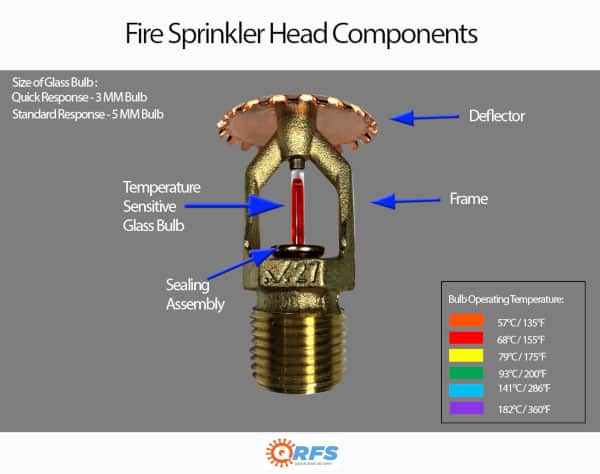
Fire sprinkler bulb temperature ratings vary
A fire sprinkler’s temperature rating is the temperature at which the sprinkler will activate, which closely tracks rising ceiling temperatures. Options range from 135 to 650 degrees Fahrenheit (38 to 343 degrees Celsius). These ratings can be identified by the color of the liquid inside the bulb in the case of glass-bulb sprinklers, or the color-coded paint swipe or dot on the frame of fusible link sprinklers (both listed below):
From the 2019 edition of NFPA 13 (Table 7.2.4.1)
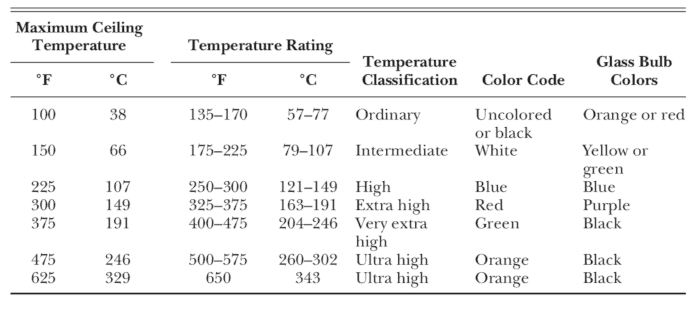
Standard response or quick response fire sprinklers depend on fire code and fire-safety priorities
Not all fire sprinklers are designed for the same purpose. Quick-response sprinklers are common in dormitories, hotels, auditoriums, and other places where many people gather. Standard-response sprinklers are primarily found in industrial and commercial spaces where keeping a building and its contents intact is a priority.
Quick response fire sprinklers cool walls, ceilings, and surrounding air to give a building’s occupants a chance to escape by controlling the fire and delaying flashover — a deadly chain reaction resulting in the total ignition of and loss of all oxygen in a room. Glass bulbs utilized in quick response fire sprinklers are 3mm in diameter. Because they’re smaller than the 5mm bulbs used in standard response sprinklers, 3mm glass bulbs are more sensitive to changes in heat and thus activate earlier than standard-response heads.
Response times vary according to the characteristics of the room and the fire, but differences in thermal sensitivity between these sprinkler types can lead to activation times that differ by ten seconds or more. Research over the past three decades shows that these extra seconds can have significant implications for human survival during a fire.
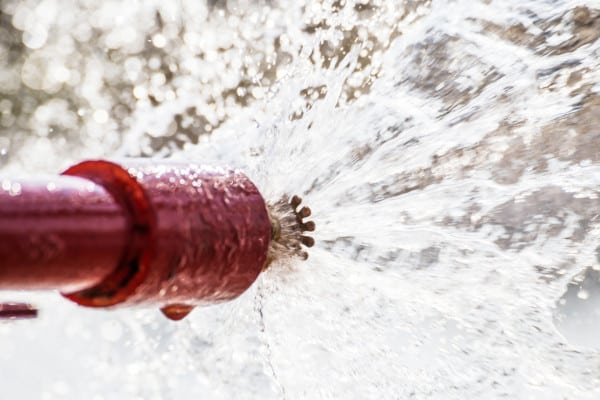
Fire sprinklers with a larger K-Factor discharge more water at a given pressure
Fire sprinklers with bigger K-factors have a larger orifice, allowing them to discharge more water at a specific pressure and to produce bigger water droplets that are more capable of penetrating fires. The most common K factors are 5.6k for fire sprinklers with a 1/2″ (12.7mm) thread connection and 8.0K for fire sprinklers with a 3/4″ (19.1 mm) thread connection.
Buildings with larger “fire loads” — defined in section 3.3.5 NFPA 557: Standard for Determination of Fire Loads for Use in Structural Fire Protection Design (2023) as a measurement of the total energy content of combustible materials in a building — should be protected using fire sprinklers with larger K-factors. Fire sprinklers for light-hazard environments (including many churches, offices, and apartments) must provide one-tenth of a gallon per minute per square foot, as much as two-tenths of a gallon per minute per square foot in ordinary-hazard environments (such as parking garages), and up to four-tenths of a gallon per minute per square foot in highly flammable extra-hazard spaces.
In short, fire sprinklers are expected to deliver more water while covering a smaller and smaller area as hazards increase. Sprinklers can cover up to 225 square feet in light-hazard environments; up to 130 square feet in ordinary-hazard environments; and up to 100 square feet in extra-hazard environments.
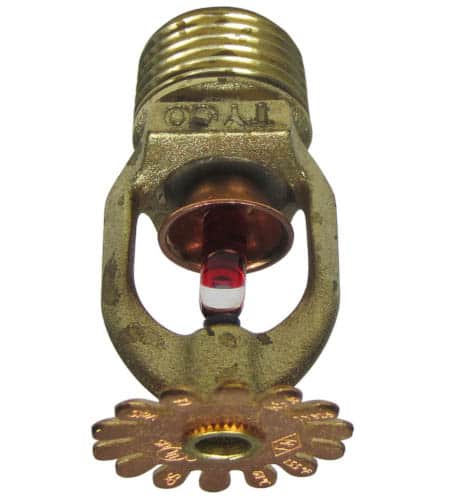
What is a pendent sprinkler head?
A pendent (sometimes incorrectly spelled “pendant”) fire sprinkler hangs from above-ceiling pipes and distributes water in a domed or conical pattern using a convex deflector. Unlike concealed pendent sprinklers which hide behind decorative plates, the head of a traditional pendent fire sprinkler remains visible after installation.
Major manufacturers offer pendent fire sprinklers in a range of K-factors, orifice sizes, and spray patterns to protect buildings of all kinds, from multi-level warehouses to daycares. The most common pendent fire sprinkler has a 1/2″ (12.7 mm) thread connection and a 5.6 K-factor, like those found in Viking’s VK3021 and VK1021, Tyco’s TY323, Victaulic’s V2708 FireLock, and Senju’s ZN-QR flush pendent sprinklers.
Slight differences in a pendent sprinkler’s safety approvals and listings, design, and manufacturing process can make one sprinkler much better suited to some environments than others, however.
Listings
Listings and approvals from UL and FM Global attest to a fire sprinkler’s suitability for fire protection service and are standard for sprinklers installed in the United States. But some pendent sprinklers, like Viking’s VK302 and VK102, boast an especially large number of approvals from international organizations – such as Germany’s VdS and the China Certification Center for Fire Products (CCCF) – that underscore their quality and readiness for import or installation abroad.
Corrosion-resistant finish
Listings also extend to fire sprinklers’ protective coatings. While there’s no universal corrosion-resistant finish, special coatings produced in accordance with NFPA 13 (2022: sections 3.3.215.4.3 and 16.2.2.1– 16.2.2.1.2) ) extend the life of key components in places like indoor swimming facilities, steam rooms, and coastal hotels, as well as factories and industrial spaces where corrosive vapors are present. For example, Tyco’s white polyester coating, used with pendent sprinklers in the TY-B family of 5.6K quick and standard response sprinklers, is both UL and C-UL-listed for corrosion resistance. So are Viking XT1 sprinklers that have specific finishes: white polyester, black polyester, or ENT.
Casting
Many pendent sprinklers visibly protrude from the ceiling, leaving the frame visible. The frame at the core of each fire sprinkler is manufactured in a process called metal casting, where liquid metal takes shape as it cools inside a hollow mold. Die-cast frames, like those found in Victaulic’s 5.6K V27 FireLock pendent fire sprinklers, are made under high pressure in a metal mold and have a smooth, even surface free of the small indentations found on other sand-cast sprinklers.
Flush pendent fire sprinklers
Flush pendent sprinklers, like Senju’s ZN-UF “true flush” pendent sprinkler, take aesthetics one step further by keeping the sprinkler’s working parts out of sight. While they’re similar to concealed pendent sprinklers, flush fire sprinklers have no cover plate to reinstall when the sprinkler discharges, thereby simplifying replacement.
Fire sprinkler escutcheons
Most pendent sprinklers also have accompanying decorative rings called escutcheons to cover holes in the sheetrock at the point of entry. They aren’t only decorative, however. Installing pendent sprinklers in a large-cut hole without the specifically compatible manufacturer’s escutcheon — or with no escutcheon at all — allows rising heat to bypass the sprinkler head, potentially delaying the discharge of water.
There are three main types of fire sprinkler escutcheons:
- Flat escutcheons for sprinkler frames that are installed flush with the ceiling
- Adjustable escutcheons for frames that hang as much as 2″ below the ceiling
- Recessed escutcheons for frames installed slightly above the ceiling.
Escutcheons must be specifically approved for use with a particular fire sprinkler (NFPA 13 7.2.6, 2022 edition) and be appropriately sized for that sprinkler’s K-factor, or orifice size. Recessed pendent sprinklers in Tyco’s TY-B series sprinklers only use Style 15 or Style 20 escutcheons, Viking’s VK102 and VK 302 sprinklers require the Model E-1/F-1 escutcheon, and Victaulic’s V27 series require V27 recessed escutcheons.
Putting it all together
While pendent fire sprinkler heads are far and away the most common type used, careful selection of core features, decorative benefits, and coatings can lead to an extended product life as well as an installation that’s easier on the eyes. If you’ve found what you’re looking for, click here to view our selection of pendent fire sprinklers.
Click here to return to our table of contents.
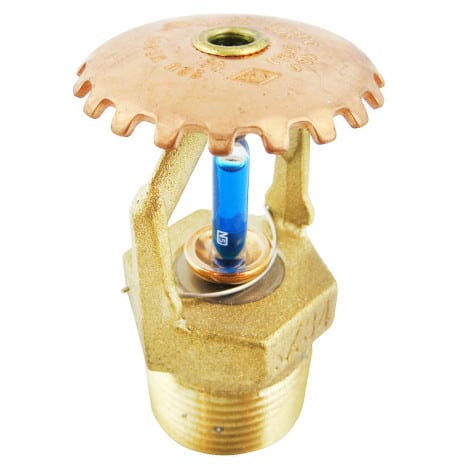
What is an upright sprinkler head?
Upright fire sprinklers spray water upward to a concave deflector, producing a dome-shaped spray pattern. They install deflector-up to cover specific areas and to prevent ice and debris from collecting in the head. Upright sprinklers are installed where obstructions interfere with coverage in many system types and in dry-pipe systems facing freezing temperatures.
Upright fire sprinklers are often used in warehouses or industrial spaces, along with renovated open-ceiling structures such as modern office buildings and chic restaurants. For industrial, commercial, and storage spaces, most suitable upright sprinklers feature a 3/4″ (19.05 mm) thread connection with an 8.0 K-factor, such as those found in Viking’s VK2001 and Victaulic’s V3402. Many upright sprinklers are also available with the smaller 5.6K orifice, including some in Tyco’s TY-FRB series, Victaulic’s V27 series, and Viking’s VK300 models.
But while upright fire sprinklers are a mainstay of nearly all fire sprinkler manufacturers, not all upright fire sprinklers are identical.
Installation
Upright sprinklers installed on branch lines must be installed with the frame arms parallel to the branch piping unless the manufacturer prescribes a different orientation; this minimizes obstruction of the spray pattern. Fire sprinklers in Victaulic’s V27 and V34 series — including the 5.6K V2703 and V2704 and the 8.0K V3401 and V3402 — are cast with a hex-shaped protrusion, called a wrench boss, designed to provide a contact surface for wrenches to securely grip, rotate, and install sprinklers in the correct orientation.
Corrosion-resistant coatings
In 2012, Viking introduced a corrosion-resistant electroless nickel PTFE (ENT) coating to several products in their commercial sprinkler line. In doing so, Viking joins Victaulic and others in providing a finish capable of surviving UL 199’s rigorous 30-day corrosion-exposure test with little to no evidence of rust. Alternatively, many of Viking’s standard response upright sprinklers, including the 5.6K Micromatic VK100 and the 8.0K Micromatic VK200, are also available with UL-listed and FM-approved corrosion-resistant coatings and finishes.
Aesthetics
While upright fire sprinklers can’t be recessed or hidden behind a cover plate, system design can make upright models less of an eyesore. Tyco’s Series TY-FRB sprinklers are available with a 5.6 K-factor, minimal frame, and narrow bulb and are designed for banks, hotels, and other commercial occupancies where appearances matter.
Early Suppression, Fast Response (ESFR) sprinklers
First developed in the 1980s, early suppression, fast response (ESFR) sprinklers have revolutionized the control and suppression of fires in storage settings with large k-factors and high-momentum sprays designed for deep penetration of burning fuel and fire plumes. Tyco has innovated in the market, introducing some of the earliest ESFR sprinklers, developing sprinklers for select cold-storage facilities in 2012, and transitioning from earlier ESFR models to their low-profile 16.8K Model ESFR-17 fire sprinkler line in 2015.
Putting it all together
The right upright sprinkler can keep even the most extreme fire conditions in check, endure corrosive vapors, install easily, and interfere only minimally with architectural and design needs. If you’ve found what you’re looking for, click here to view our selection of upright fire sprinklers.
Click here to return to our table of contents.
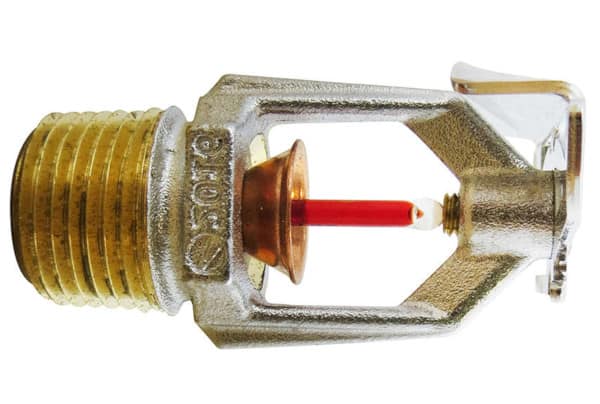
What is a sidewall sprinkler head?
Sidewall fire sprinklers install along walls or beneath beams where ceiling piping is unavailable, or where aesthetic concerns or obstructions weigh against the use of other sprinkler types. Most are designed to protect small rooms, closets, or hallways and have a semicircular deflector that produces a crescent-shaped spray pattern.
Horizontal sidewall sprinklers should only be installed below smooth, flat, horizontal ceilings in accordance with their listings, approvals, and NFPA guidelines. They are used in hotels, restaurants, churches, and a range of commercial structures, and most sidewall fire sprinklers utilize a 1/2″ (12.7 mm) thread connection and feature a 5.6 K-factor.
Standard finishes for most manufacturers’ horizontal sidewall sprinklers — including those within Tyco TY-FRB series fire sprinklers, Viking’s Microfast and Micromatic series, and Victaulic’s V27 series — include white, black, brass, and chrome. Each manufacturer offers a slightly different variation on the sidewall sprinkler. These differences, including the factors listed below, can streamline installation and extend product life.
Installation
In 2018, Viking introduced 8.0 K-factor dry horizontal sidewall sprinklers with redesigned deflectors listed for installation with the deflector placed anywhere from four to 12 inches beneath the ceiling. Viking’s recent line of listed sprinklers provides contractors with the same ease of installation offered by the company’s other sidewall models, including the 5.6 K-factor VK305 and the VK104.
In 2016, Tyco merged with Johnson Controls, joining two global companies with wide-ranging industrial and building expertise. Johnson Controls subsequently announced a range of new products for Tyco sprinklers, including a straight-thread, tapeless adapter, called Rapid Seal, to expedite fire sprinkler installation in systems that use CPVC pipe and fittings. Rapid Seal promotes precision placement and orientation — an especially useful feature when it comes to installing Tyco TY-FRB series fire sprinklers and other sidewall sprinkler heads.
Coatings
While aftermarket paints ruin fire sprinkler heads, manufacturer-supplied coatings can extend their longevity by protecting against corrosion. Most manufacturers, for example, offer corrosion-resistant PTFE (ENT) coatings. But in 2014, Victaulic introduced the VC-250 coating to their FireLock sprinkler line. It’s capable of withstanding exposure to a larger number of chemical substances, including hydrogen peroxide, sodium hydroxide, ammonia, and nitric acid. VC-250 coatings are available with Victaulic’s 5.6 K-factor sidewall fire sprinklers in the V27 family and their V34-series 8.0K sidewall fire sprinklers.
Putting it all together
Sidewall fire sprinklers require careful, code-compliant installation, a process that depends on the right listings and accessories. All manufacturers offer protective coatings for sidewall sprinklers, but these coatings should be selected with the specific chemical hazards facing the sprinkler in mind. If you’ve found what you’re looking for, click here to view our selection of horizontal sidewall fire sprinklers.
Click here to return to our table of contents.
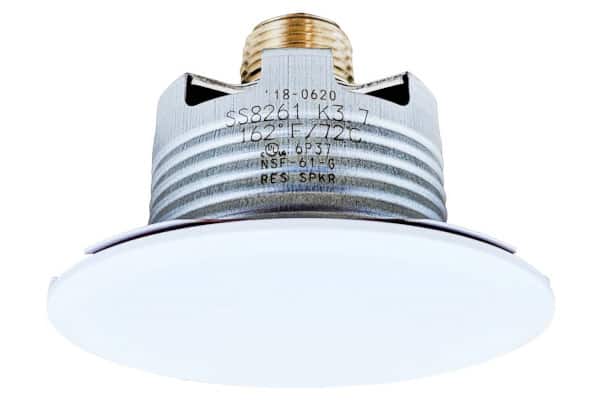
What is a concealed sprinkler head?
Concealed models install in walls or ceilings and fully cover a pendent or sidewall sprinkler head using a concealed fire sprinkler cover plate. This heat-sensitive plate detaches at temperatures roughly 20 degrees (F) lower than the fire sprinkler head, allowing the concealed sprinkler’s deflector to drop and the head to activate.
Like pendent, upright, and sidewall sprinklers, most concealed models have a 1/2″ (12.7 mm) thread connection and a 5.6 K-factor, including Victaulic’s V3802, Senju’s SS2521, and Tyco’s RFII (Royal Flush) series. Fire sprinkler cover plate temperatures vary with the head’s activation temperature but are often set at 139F (59 C) for 155F (68C) sprinklers and 165F (74C) for 200F (93C) sprinklers.
The look of fire sprinkler cover plates varies enormously from manufacturer to manufacturer. While most sprinkler heads are available in white, chrome, black, or brass, cover plates are available in a wider range of finishes, including wood pattern, metallic, and, in some cases, custom-painted versions.
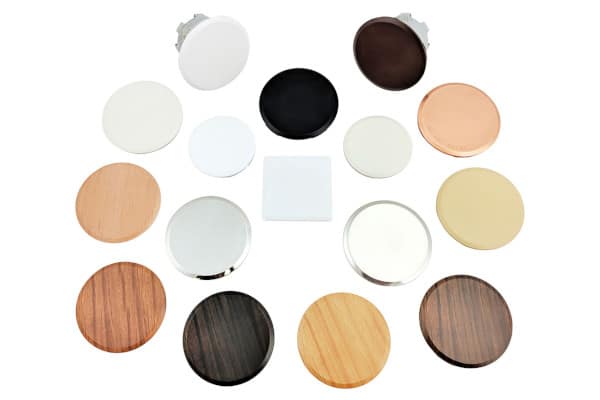
Senju, Japan’s largest fire sprinkler manufacturer and the maker of that country’s first fire sprinkler, has expanded rapidly in the past decade, increasing storage space to house an inventory that, at times, has barely kept pace with growing demand. Part of Senju’s success is their distinct collection of standard-finish cover plates — including beige, nickel, Douglas Fir wood grain, and numerous other colors and patterns — and a fast turnaround for custom, image-based cover plates. Senju makes these plates available throughout much of its product line, including its 5.6 K-factor CN-QR sprinklers.
Because fire sprinkler cover plates should never be painted and must always be replaced with the manufacturer’s approved plate, Senju’s aesthetic line fills a sorely-needed niche for elegant buildings in need of fire protection.
If you’ve found what you’re looking for, view our selection of commercial concealed pendent fire sprinklers, or click here to return to our table of contents.
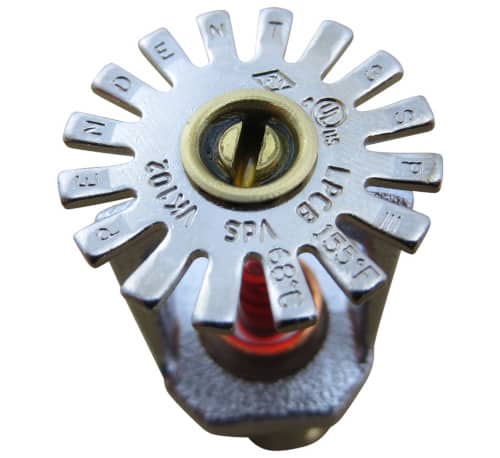
More fire sprinkler types for special applications are available
The sprinkler head types discussed above are far from the only options available. Over the years, manufacturers like Tyco have developed many specialty sprinkler heads for very specific applications. Extended Coverage Light Hazard (ECLH), Extra Large Orifice (XLO), vertical sidewalls, and mist systems are each well-suited to specific environments and fire hazards.
There is no “best” fire sprinkler — only the right model for a specific coverage area’s needs. Licensed fire sprinkler designers and installers are key to ensuring that the sprinkler type, location, response type, K-factor, and temperature are customized to the fire hazard, occupancy type, and architectural design of a structure.
View our full selection of fire sprinklers and accessories. If you have any questions or otherwise need help selecting them, give us a call at 888.392.3362, comment below, or fill out our contact form and we’d be happy to assist you.


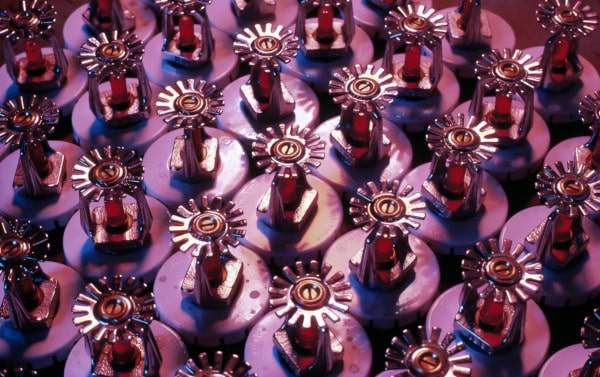
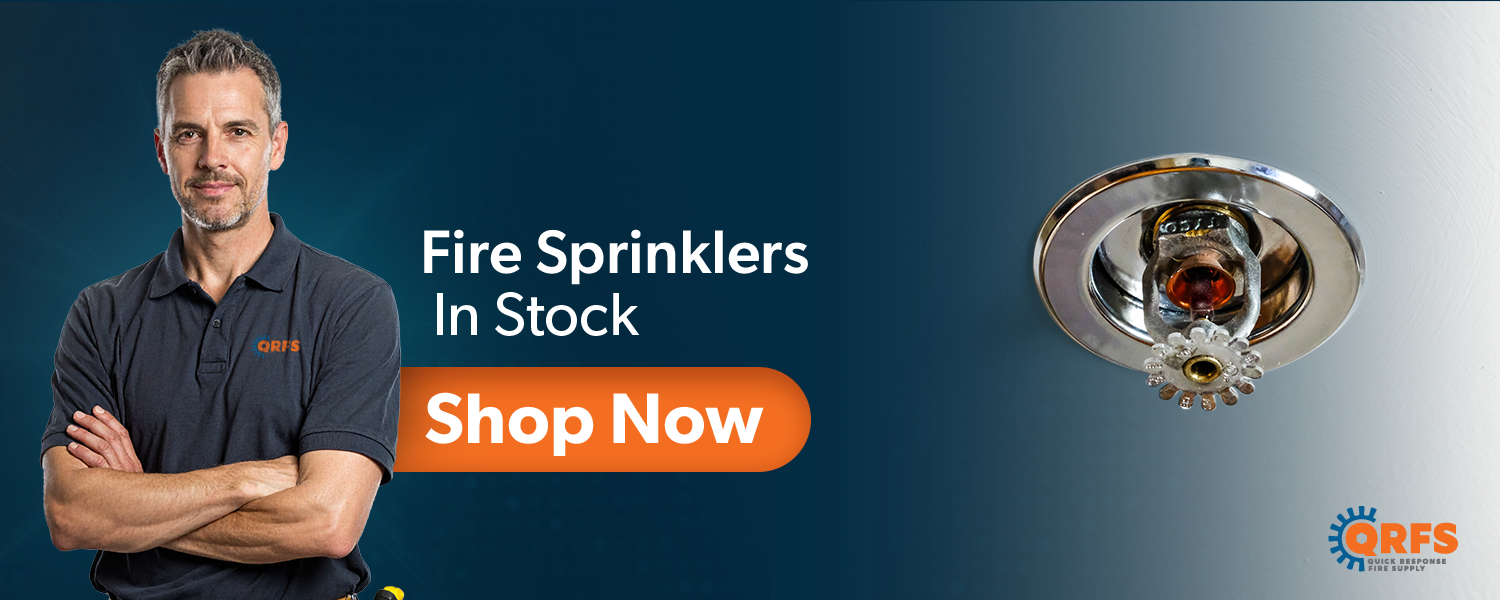
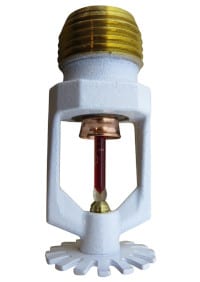
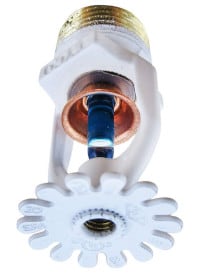
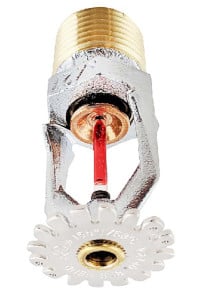
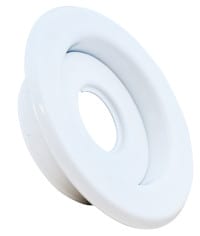
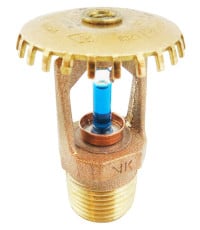
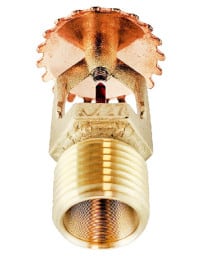
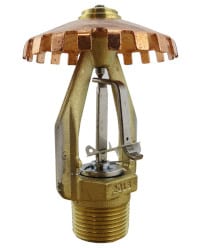
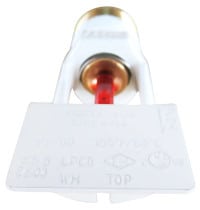
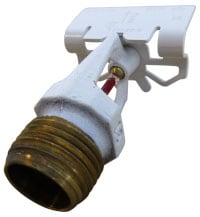
I have 2 sprinklers in my ceiling that were installed about 10″ from a faux beam that sticks down 3 1/2″. They planned to install a concealed sprinkler but I’m now being told it won’t pass inspection. Do you have a sprinkler head that would extend pass the faux beam once set off or any options that don’t require cutting open our ship lap ceiling? Hopefully one that is not too ugly.
Scott, thanks for commenting! To help you identify the right sprinkler, you need to work with a licensed fire sprinkler contractor and/or local authority having jurisdiction to determine what you need to pass inspection. Fire sprinklers come in a variety of different finishes, vary slightly in their overall length, and potentially can be paired with an extension . Again, a licensed professional will be the best person to help you determine a solution!
I have fire springler system in my home. Now I need to decide which degree temp they should be, 2 heads are approx. 21 ft. on 6/12 pitch ceiling above great room floor, 2 heads are 24 ft. above same floor flat ceiling, and 2 heads are on 6/12 pitch ceiling 10 ft above dinning room floor. these 6 heads are in the same open floor space area, of 800 sq. ft. 20 x 40 space. the system is 1 inch orange fire pipe. Pendent type
Thomas, thanks for reaching out. Fire sprinkler temperatures range from 135 degrees to 286 degrees Fahrenheit. Our most popular temperature is 155 degrees Fahrenheit. You should work with your authority having jurisdiction (AHJ) or fire marshall to determine specific requirements for your local residential fire code. To learn more about thermal sensitivity for fire sprinklers, you can read our blog on How a Fire Sprinkler Works.
We are considering installing sprinklers into chemical laminar flow fume hoods where hot acid vapors (metal attacking vapor like hydrochloric acid) are used. We are researching if recessed acid resistant sprinkler heads with acid resistant cover plates are an option. Do you sell acid resistant (e.g., Teflon coated) cover plates? If so, it could really help.
Thanks,
Mark
Mark, thanks for reaching out! We don’t have acid-resistant cover plates in stock. However, we can help you procure fire sprinkler heads and covers to meet your needs if you are interested in pursuing a quote. You can contact us support@qrfs.com or 888-361-6662.
I have a home with horizontal sidewall sprinkler heads that are very unsightly. Can they simply be replaced with concealed horizontal sidewall sprinkler heads without making modifications to the CPVC piping, or are there dimensional differences between the two types that would require modification in order for the concealer plates to lay flush against the wall?
Scott, there are two options for you to consider. First, you can replace the sprinkler with the same sprinkler model in a different finish. Nearly all sprinklers come in brass, white, and chrome. Second, you could find a new sprinkler (a concealed sprinkler or a sprinkler with cover plate) – this option may require changes to the piping depending on your current sprinkler configuration. For both options, you should work with a licensed fire sprinkler contractor and your local authority having jurisdiction to ensure proper replacement and functionality of the sprinkler system. A licensed fire sprinkler contractor can also provide options estimates for replacements.
In researching another fire sprinkler issue, I have just found out that the Central Omega R-1M sprinklers installed throughout my house have been recalled quite awhile ago. I purchased the home in July 2018, and nothing was mentioned in the inspection. Everything I have read would indicate I am long past any recall dates. Do you have any suggestions for recourse?
Michael, thank you for reaching out. Unfortunately, recalled sprinklers do need to be replaced to ensure the proper functioning of your fire sprinklers. Central, now owned by Tyco, has a product customer support team that can help you identify a suitable fire sprinkler replacement. Once you identify a replacement, you can work with a licensed fire sprinkler contract and your local authority having jurisdiction to replace the sprinkler and receive an up-to-date inspection. Hope this helps!
I want to retrofit a voluntary exterior fire sprinkler system to protect my house from wild land urban interface fires. I need a sprinkler head that will both protect the underside of the eaves (36” projection with 7.5” deep wooden tails) from updrafting embers and protect the house sidewall if a neighboring house were to catch fire. The sprinkler design professional I contacted specified just a regular pendant head which does nothing to direct water up to the eaves and does little to direct water to the sidewall. Is such a specific head available? Or, perhaps, a combination of two heads?
Thank you for any help
Jud Peake
Jud, thanks for reaching out. Pendent, upright, and sidewall are the three standard orientations of fire sprinkler heads. An upright sprinkler sprays water upward—and both upright and pendent sprinklers have coverage to each side within a specified coverage area that depends on the exact sprinkler model. Sidewall require vertical supply pipes opposite/behind the sprinkler’s spray pattern.
REGARDLESS: NFPA 13D, the installation standard that governs residential sprinklers (1-2 family homes), does not cover the installation of residential sprinklers specifically intended for protection from wildfires. There are some different sprinkler systems that have been tested for this purpose with some success, however (see the link below). We cannot recommend using common residential sprinklers for this use, but you may be able to research external systems dedicated to wildfires. Good luck and make sure you closely vet the qualifications of any potential installer of a dedicated external system.
I’m in CA where the fires are bad and was wondering if I could jury rig a system to try to protect my house in case I have to evacuate.
I have a 1/2″ water bib with 100lbs of pressure. If I put like 4 upright fire sprinklers spaced out 10-15′ running across my composite shingle roof, would 100lbs pressure be sufficient? Is there another solution you can recommend?
Joe — We’d prefer not to advise you on ad hoc system (there are no NFPA installation standards for such a setup), but there are other steps you can take to help protect your home. Read this blog and check out NFPA’s Firewise program. There are also some outdoor sprinkler systems that have been tested in wildfire areas, but we do not sell that specialized equipment.
Does the glass bulb have an expiry date?
Paul — Sort of, but it’s a long horizon. After installation, quick response sprinklers need to be tested in 20 years and then every 10 years after that, standard response tested in 50 years followed by every 10, and dry pendent sprinklers every 10 years. When sprinklers are exposed to cold or sunlight, the liquid bulbs may lose color, but this is typically just temporary based on temp and doesn’t impact activation; but if the liquid is missing for some reason, that’s a problem.
Please I want you to teach me how to calculate the area of hydraulic
Kevin — We don’t do training, but you can take courses from the National Fire Sprinkler Association, FireTech Productions, and other good training providers as part of professional programs! Best of luck!
Where can I purchase a sprinkler head small for a experimental test regards Lance Carlyle.
New Zealand
Lance — You can purchase a sprinkler at QRFS, choosing from our selection of commercial and residential sprinklers, though be cognizant of the shipping!
WE just had a fire sprinkler burst by itself and not knowing the root cause causing our warehouse flooded with water. What is the best way to find out whether it cause by the sprinkler head pre-mature failure on key components ie glass bulb, sealing, etc or due to the fire sprinkler system design.? Any standard test out there that can be used to do proper failure analysis of the failed part or any of the existing unit in the operation. Can we also test the sprinkler head to find out the glass bulb strength versus the any specifications where it shows it can withstand certain pressure or vibration impact other than temperature heat.?
Zack — These are all good questions, but the answers depend on your system and circumstances, including factors like its age or whether anything may have impacted the sprinkler head (pretty common in warehouses). If sprinklers are old and/or you suspect they might malfunction, a sample of them can be submitted to a recognized testing laboratory. As for a more in-depth answer, you should consult a qualified fire protection contractor in your area, or you can try our Ask a Fire Pro service. Click the link to submit your question with some information about your building and system, and a fire protection professional will provide an answer based on best practices, standards, and codes. Our pros include AHJs, contractors, engineers, and code experts with 150+ years of combined experience!
I have a commercial space, with pendant style sprinkler heads that drop below a suspended ceiling (acoustic tile). They have the recessed escutcheon with a protective cage. I use my space for exercise classes, and the 10′ high ceiling is low enough that I worry something could hit the pendant and break the glass causing the sprinkler to go off. I have had cages installed around the pendants, but if a ball or a jumprope were to hit the cage, I’m not confident it would stay secured and prevent setting off the sprinkler.
If I were to hire an authorized company to switch the pendant style to a concealed style sprinkler:
a) would that give better protection than pendant with cage
b) would the new sprinkler head simply be swapped out, or instead would the water pipe need to be shortened to allow the concealed style sprinkler to be flush with the acoustic ceiling tile?
I’m trying to understand how much work needs to be done to switch styles, and if that work would actually be better at preventing an accidental activation of the sprinkler system.
Patrick — without having more detail on your system, any answer we give you on how much work it would take is necessarily imprecise. It depends on exactly where the new sprinklers would be mounted, in what, and if there is any ‘play’ (room to adjust up or down) between the supply pipe and the current recessed pendents (e.g., sprinklers are connected with extensions/drops). You need to contact a sprinkler professional in your area and have them take a look. If there isn’t any room to maneuver (assuming a replacement concealed model meets the same design/discharge density needed) then yes, you may be looking at a significant retrofit.
As to whether a concealed model provides more impact protection: theoretically, it might, because of the cover and simply because that type of installation will give you a little more clearance to the sprinkler head. But a hit may still knock the cover off, and a hard enough hit could damage the cover and assembly. Again, you should consult a local pro and ask them to assess the options for your specific situation.
We have a customer that purchased a diesel generator and they are installing the generator in a room that has a fire sprinkler above the generator. We are reluctant to start the generator to test it because we are afraid the sprinkler will open up and spray water in the room due to the heat coming from the diesel engine. What options do we have for this case? Should we be recommending that the customer remove the sprinkler that is above the generator?
David — Sprinklers have different possible activation temperatures to account for ambient heat from different sources, and NFPA 13 provides a table (Table 9.4.2.5(a); 2022 edition) that specifies heat sources, minimum distance from the heat source, and the appropriate sprinkler temperature rating. Generators are not listed, however. We do not know how close the sprinkler is to a generator, nor how much heat it gives off. To determine the potential course of action, you should contact a qualified fire sprinkler pro or AHJ (e.g., fire marshal) in your area. They can assess the specific situation and provide definitive guidance. Thanks for reading.